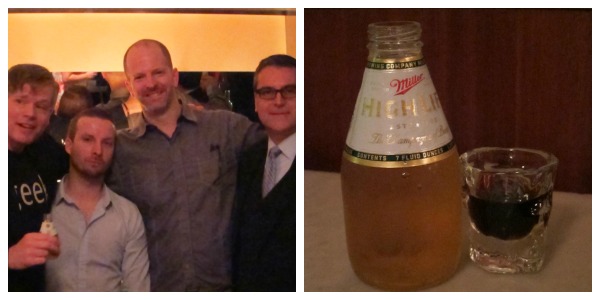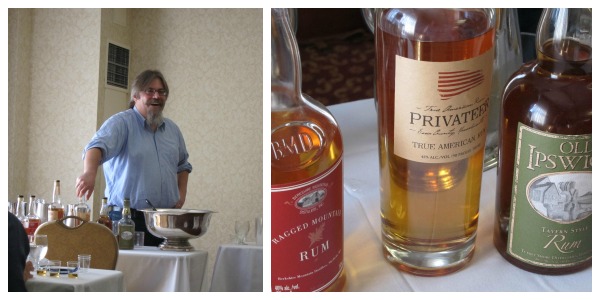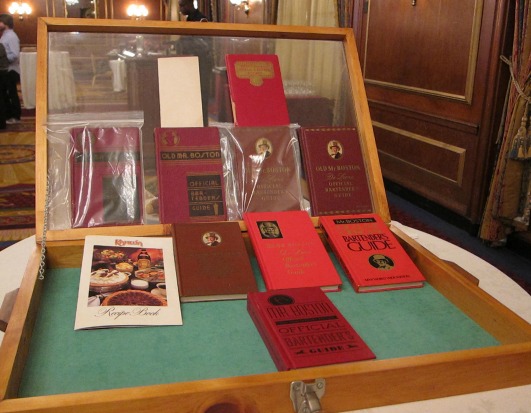What You Missed at This Weekend's Boston Cocktail Summit
 All photos by Christopher Hughes for Chowder
All photos by Christopher Hughes for Chowder
At the forefront of the renewed interest in all things old-school food and drink related is the classic cocktail—it’s equal parts nostalgia and intellectual intrigue, with perhaps a dash of dapper American cool. Boston celebrated its role in this revival over the weekend, with the first annual Boston Cocktail Summit, which not only celebrated local bartenders and cocktail authorities, but also welcomed stars from all over the country. From distillers to the famous Dale DeGroff, who resurrected the antiquated term “mixologist,” all manner of booze-y royalty congregated to share their favorite drinks, the ever-evolving history of alcohol in New England, and most importantly, their favorite stories from behind the bar.
Ahead, get a look at some of the action over the weekend. For your own benefit, I’ve included a section called “Stolen Party Anecdotes” for all those upcoming holiday parties. Feel free to pass these off as your own at your next company outing or friendly get-together. I know I will.
Thursday, October 4th
The History and Change of the Downtown Bar Culture
 Left: From left, John Gertsen, Ryan Mcgrale, Josh Childs, Tom Mastricola. Right: Every bartender’s favorite post-shift combo, the Miller High Life pony and a shot of Fernet.
Left: From left, John Gertsen, Ryan Mcgrale, Josh Childs, Tom Mastricola. Right: Every bartender’s favorite post-shift combo, the Miller High Life pony and a shot of Fernet.
The growing pains of a fledgling event, no matter how prodigious, became apparent almost immediately—namely in excruciating scheduling issues. A number of events either ran at the same time or overlapped in parts as other tempting seminars. So, unless you wanted to be that person, shuffling between tight rows of seating and trying to quietly excuse yourself despite yowling hotel doors (Park Plaza Hotel, I’m talking to you, invest in WD-40!), the number of possibilities per day were fairly limited.
I got lucky on Thursday. The History and Change of the Downtown Bar Culture, was, without a doubt, the best event I attended all weekend. Located in the speakeasy atmosphere of Silvertone’s back Chez Freddie room, owner Josh Childs hosted three luminaries of the recent Boston cocktail resurgence: Tom Mastricola, the opening bar manager for No. 9 Park and now General Manager at Clio;? John Gertsen, a dead ringer for Michael Pitt, who trained under Mastricola at No. 9 Park and who helped establish the sterling bar program at Barbara Lynch’s Drink; and Ryan Mcgrale of Storyville, soon to be at chef Louis DiBiccari’s forthcoming Fort Point restaurant, Tavern Road.
Silvertone was a fitting venue as it was the 2000’s bartender version of the Algonquin Hotel in the 1920’s—the famed meeting place for notable writers and entertainers like Groucho Marx and Dorothy Parker. Mastricola, Gertsen and scores of other influential bartenders hung out after-hours at Silvertone, exchanging inventive cocktail ideas and creating the new standards. During the seminar on Thursday, they served some of their more-heralded drinks, including: No. 9 Park’s No. 10 (Tanqueray 10 blended with plenty of fresh grapefruit juice and Campari); No. 9 Park’s Palmyra (essentially a Vodka Gimlet with refreshing lime and mint); and an 1806 version of the Old-Fashioned (sans fruit and with cognac substituted for whiskey).
Highlights included theories swirling around the origins of the Ward 8, Boston’s most revered cocktail, and its supposed history with Senator Martin Lomasney and Locke-Ober. Eventually though, the gathering started to feel like a reunion of old drinking buddies and the talks turned into shots of Fernet, chubby little bottles of Miller High Life and an off-color comparison of muddlers and Toddy sticks. What more could you ask for?
Stolen Party Anecdotes: No. 9 Park used to be famous for table 21 (unfortunately, it no longer exist), a highly competitive reservation in its heyday. During the winter, patrons would smear notches into the foggy glass of the adjoining window for every Palmrya they had consumed. One party of two allegedly set the record with 45 tally marks.
Friday, October 5th
Medford Gold: Rum and the Soul of New England ?David Wondrich and Wayne Curtis
 Left: David Wondrich; Right: A selection of great local rums (read below for deets).
Left: David Wondrich; Right: A selection of great local rums (read below for deets).
On Friday afternoon, David Wondrich (cocktail writer for Esquire) and Wayne Curtis (editor and “designated-drinker” for The Atlantic), crammed the storied history of rum in the U.S. into ninety fascinating minutes. Before last weekend, I never made the linear connections between rum, Boston baked beans and molasses cookies. Thanks to Wondrich and Curtis, now I know it’s because molasses was once considered a useless byproduct of the sugar cane industry. New Englanders, living up to their thrifty reputation, bought it in bulk from British colonies in the Caribbean.
Before Irish and Scottish immigrants in Pennsylvania and Indiana were introducing rye whiskey, New England rum was the most highly sought after spirit in the country. But, like a number of iconic brands, it was crippled by Prohibition and devolved into cheap plunk. It was so bad, that Lydia Child in The American Frugal Housewife saw it fit only for washing itchy scalps. Fortunately, a new breed of serious rum producers is again distilling in the area. We were lucky enough to sample Old Ipswich Tavern Style Rum, which had hints of vanilla and hazelnut and an incredibly silky finish; Privateer True American Amber, which was rich and viscous with heavy notes of brown sugar; and Berkshire Mountain Ragged Mountain Rum, which had delicate floral aromas and big apple cider notes.
Stolen Party Anecdotes:
1. After Prohibition, New England rum was so reviled that “rum” became synonymous with cheap booze. Hence, the word “rummy” for the derelict and drunk.
2. Johnny Appleseed was not planting green Rambo apples for table consumption. He was planting apple trees for cider and brandy distillation. Now that’s a true patriot!
Saturday, October 6th
I’ll Take Manhattan with Brother Cleve
 Left: Brother Cleve; Right: The panel for The Future of Bourbon (see below).
Left: Brother Cleve; Right: The panel for The Future of Bourbon (see below).
Brother Cleve is considered the “Godfather” of the Boston bar scene because of his efforts to revitalize the classic cocktail, beginning in the 80s. Now he’s a prized consultant and author who has spent the last year at First Printer in Harvard Square and will soon be concentrating his efforts in Concord at the Colonial Inn. At his newest venture, he’s implementing 19th and early 20th century techniques like (hopefully!) using a hot poker to make traditional flips. There are a lot of myths surrounding the origins of the Manhattan cocktail, all of which seem to have been debunked in the recent past. Despite its muddled beginnings, we know the Manhattan had its first documented appearance in 1874. Different variations have been sprouting up ever since, but attendants sampled the three most common recipes with varying amounts of bourbon, rye, sweet vermouth and angostura bitters. One standout: a recent manifestation out of San Francisco, the black Manhattan, which gets its dark hue from Amaro.
Stolen Party Anecdotes:
1. The ice business was started by a New Englander, Frederic Tudor, who cut out large cubes from a Massachusetts pond and shipped it using sawdust. This was the main invention that fueled the modern cocktail.
2. Because dental care was practically non-existent in the early 19th century, iced beverages had the tendency to scald teeth. The first drink to utilize commodity ice was the Mint Julep. To protect the thinly shielded nerve-endings, a crafty bartender created a metal straw. Hence, the Mint Julep is the reason we have straws today.
The Future of Bourbon-Noah Rothbaum, David Pickerell and Mike Reppucci
Journalists and bartenders are continually looking for the next fashionable spirit to open up elusive flavor combinations. Unfortunately, for large whiskey distilleries, they’ve exhausted the possibilities of aging, proof, and finishing barrels. This is where producers, like Mike Reppucci from Rhode Island’s Sons of Liberty, have surpassed the big boys. With smaller pot stills and a lower overhead, the threshold for experimentation is reaping huge rewards. Writer Noah Rothbaum with David Pickerell, former master distiller at Maker’s Mark, joined Reppucci to discuss how the Jack Daniels’ of the world are looking toward craft distillers for the next great movement in whiskey. In the near future, look for novel single grains like spelt and sorghum to become darlings in mixology circles. Also, expect crafty whiskey makers to follow in the footsteps of guys like Reppucci who are handling their product like higher proof beer. Sons of Liberty has a small-production whiskey coming out that uses the same dark roasted malts as an imperial stout, and an 800-bottle seasonal offering brewed like a pumpkin-infused ale.
Stolen Party Anecdote: One of the main culprits in America’s ongoing infatuation with vodka is Joan Collins. During the 1950s, her Gatsby-esque vodka-themed soirees were the stuff of legend. The Hollywood stamp of approval have made vodka, far and away, the best-selling spirit in the country to this day.
Mr. Boston 75th Anniversary Celebration

The Mr. Boston event was a sad finale to a long and fruitful weekend. Copies of the newest edition of Mr. Boston adorned tall cocktail tables encouraging requests for Sidecars and Sazeracs. For the most part, everyone acquiesced and ordered something novel. But it was apparent from the faraway stares and the erratic conversation that fatigue had settled in. Despite the tough decisions due to time constraints, I’m looking forward to the second anniversary of the Boston Cocktail Summit. I can’t wait to see who joins the pantheon of the greats, the trending libations and especially, the newest stories accumulated after another full year behind the bar.
Ed’s note: Boston magazine was one of The Boston Cocktail Summit sponsors.
For more online food (and drink!) coverage, find us on Twitter at @ChowderBoston

